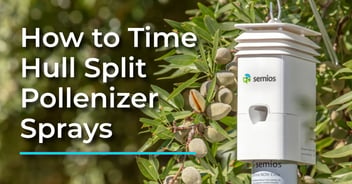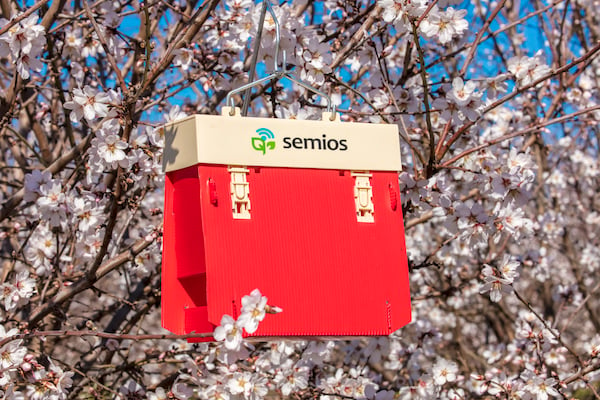
Recent reports show that 2020 degree day accumulations are shaping up to be similar to that of 2015.
“Traps have been going up early this year because it has been so warm. Heat unit accumulations since January 1 this year are similar to what we recorded in 2015, which was the earliest navel orangeworm biofix in many decades at the Nickels Soil Lab.” Franz Niederholzer, UC Farm Advisor, Colusa, Sutter and Yuba Counties.
A warm spring has meant that growers, who have their navel orangeworm (NOW) traps out early, may be seeing higher than usual adult activity for this time of year. Although this may concern some, NOW flight at this time of year does not always lead to substantial egg laying.
From our experience, NOW activity that occurs early in the season does not always lead to a meaningful second flight that would represent actual risk of crop damage.
Below is a chart of moth captures from a Semios customer in 2019. The solid lines mark dates where NOW activity was recorded. The dashed lines show 1100 DDF from those dates, which is when you would expect the development to complete for the male offspring from mummy nuts.
Note how the flight that occurred in late April (orange) did not result in a flight in early July, while the flight that occurred in June (green) led to a flight in August.
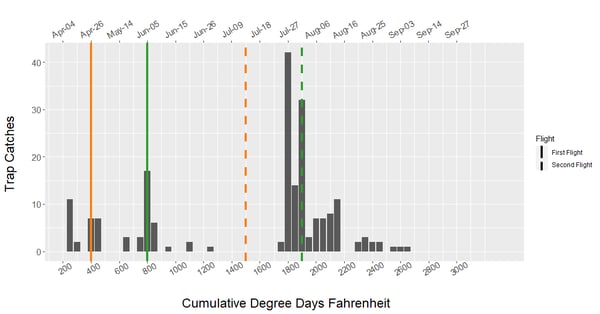
This is consistent with what we’ve seen in both pheromone traps and egg traps. The chart below shows the male catches per day for another customer. The shaded area shows when they found eggs.
Females will lay eggs between one to seven days after emergence, yet in spite of adult activity from the end of March, no eggs were detected until May.
Figure 1. Trap captures (line) and period when eggs were found (shaded area).
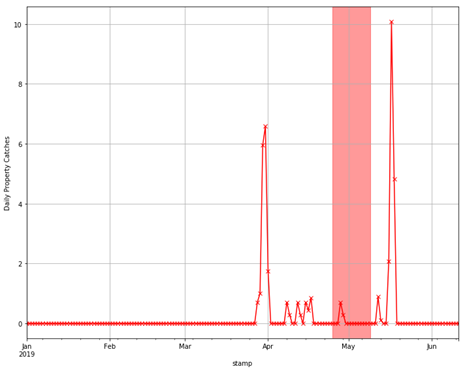
Low levels of egg laying can be expected in early spring because:
- Navel orangeworm take longer to successfully find mates under spring conditions
- Females lay less eggs the longer it takes them to mate
NOW activity is dependent on temperature and light levels. Male NOW will only respond to female calling when the temperature is 52 °F or above, and light intensity is low. Similarly, females will only call if the temperature is 54 °F or above. During the early spring, cooler temperatures mean less hours in the day in which adults are active. This can lead to delayed mating in NOW.
A study by Burks et al. (2011) found that when nightly low temperatures were between 43 °F and 48 °F, only 13% of the females put out were mated on the first night, while 20% of females were mated between 48 °F and 54 °F. After three days, 25% of the females in the first group were mated while 50% of the females in the second group were mated.
Prolonging the time before mating can reduce the number of offspring produced. Landolt and Curtis (1991) found that unmated females will continue to lay eggs at a rate of 15-20 eggs per day. Therefore if mating is delayed, by the time mating occurs, females may have less eggs for fertilization.
Looking at the nightly minimum temperatures in 2019 (Figure 3), cool temperatures may explain why flights that occurred from March to April last season did not lead to subsequent flights. Nightly minimum temperatures were within or below the 43 °F and 48 °F range.
Figure 2: Minimum temperatures in 2019

Figure 3. Minimum temperatures in 2020
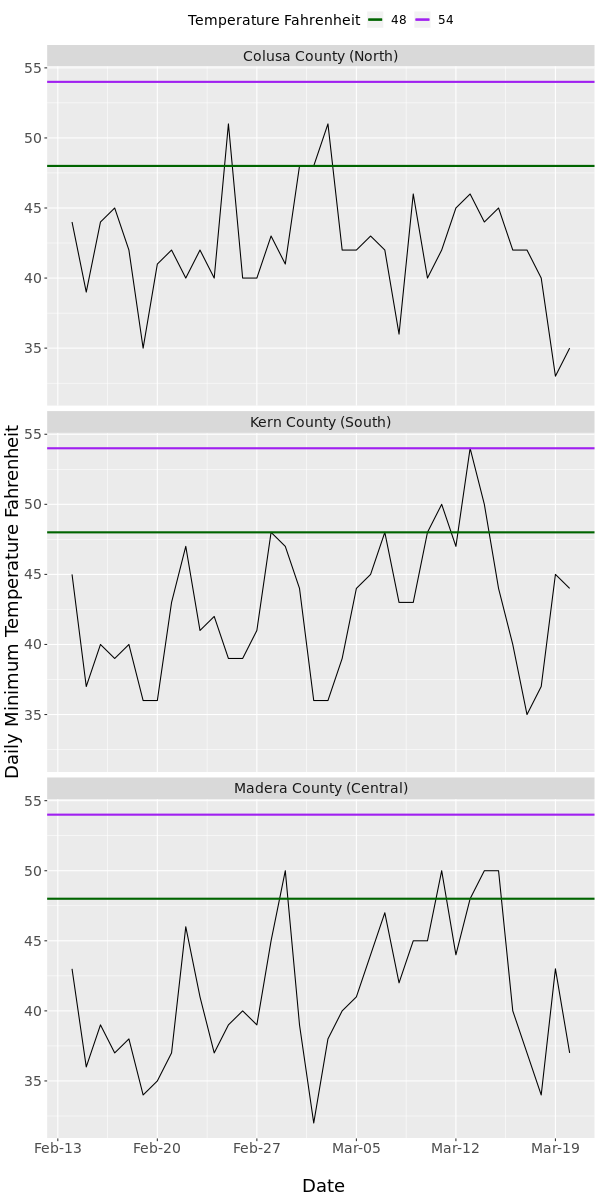
High, early-season trap captures may indicate a spring insecticide application is warranted to help manage high populations. However, make the most out of your insecticides by monitoring egg traps and following UC Extension service guidelines for spring spray timings:
“Only consider spring sprays for navel orangeworm in orchards with a history of high navel orangeworm damage and high trap captures in the central and southern San Joaquin Valley...If an insecticide is used in the spring (late April to mid-May), make the application just after the first eggs of the spring brood hatch or at the appropriate timing for peach twig borer.” UC IPM Guidelines for navel orangeworm in almonds
The Semios variable mating disruption program targets periods where successful mating and oviposition are most likely to occur.
If you are finding eggs in your traps, please do not hesitate to contact your Account Manager and we can adjust your mating disruption program appropriately.
Frequently Asked Questions
Have you turned my dispensers now?
Our NOW dispensers have been turned on as of March 16th 2020.
Could you have turned on my dispensers earlier?
Given NOW is less active and aerosol mating disruption can crystallize at lower temperatures, Semios dispensers are programmed not to spray below specific temperature thresholds. This temperature is below that which independent research has shown moths to be active.
References
Burks, C. S., Brandl, D. G., & Higbee, B. S. (2011). Effect of natural and artificial photoperiods and fluctuating temperature on age of first mating and mating frequency in the navel orangeworm, Amyelois transitella. Journal of Insect Science, 11(1).
Landolt, P. J., & Curtis, C. E. (1982). Effects of temperature on the circadian rhythm of navel orangeworm sexual activity. Environmental Entomology, 11(1), 107-110.
Landolt, P. J., & Curtis, C. E. (1991). Mating frequency of female navel orangeworm moths (Lepidoptera: Pyralidae) and patterns of oviposition with and without mating. Journal of the Kansas Entomological Society, 414-420.
Sanderson, J. P., Barnes, M. M., & Seaman, W. S. (1989). Synthesis and Validation of a Degree-Day Model for Navel Orange worm (Lepidoptera: Pyralidae) Development in California Almond Orchards. Environmental Entomology, 18(4), 612–617.
Resources
UC IPM NOW Guidelines
Understanding Variable Rate Mating Disruption
On The Fence About Mating Disruption This Season?

.png?width=352&name=Cumulative%20NOW%20Degree%20Days%20-%20April%201%20Biofix%20(1).png)
.png?width=352&name=protect%20your%20yield1%20(1).png)
